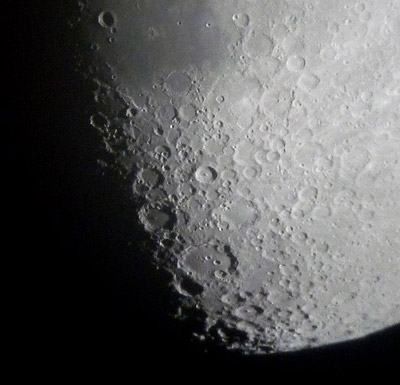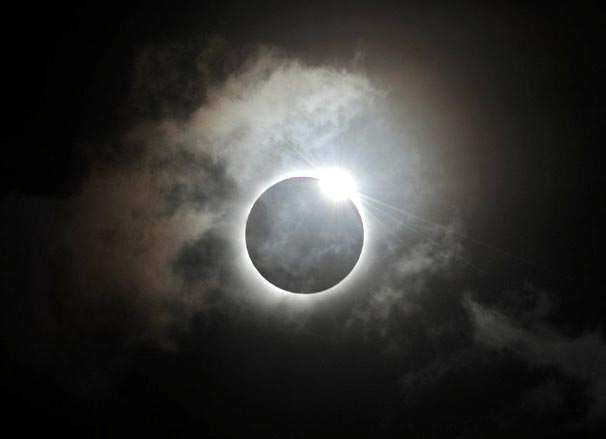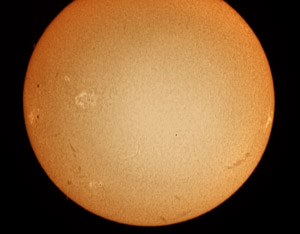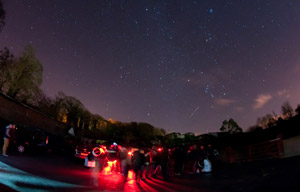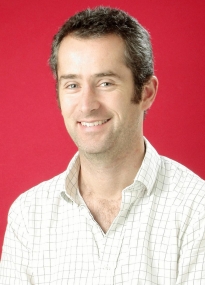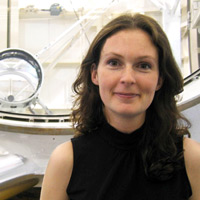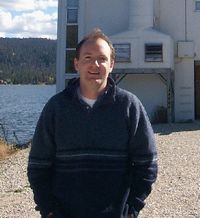We will be Observing with the Mobile Planetarium at Portballintrae Visitors' Centre from 7:30pm onwards on Friday 23rd November. The Forecast is good – a 10 day old Moon and Jupiter will be in the sky with opportunities to see many other objects through our telescopes. Indoors we'll have displays of astronomical paraphernalia and experts on hand to help you set up your telescope, so if you have one and haven't been getting the use you hoped from it, bring it along! As always, all are welcome
Eclipse Report from Andy McCrea
Total Eclipse Cairns, Queensland, Australia – 14th November 2012
After checking out the site close to Ellis Beach, roughly 5km north of Palm Cove earlier in the day, my wife Shirley and our fellow umbraphiles, Col and Marcia Maybury headed to Col’s aptly named ‘Hat tree’ beach. The name came from a hat which Col had tied to a tree on an earlier ‘reckie’ visit with his lovely wife Marcia.
When we arrived around 3am we were amazed by the beautifully clear inky black, ‘moonless’, sky with majestic Orion high in the north – but upside down of course! The Southern Milky Way stretched from horizon to horizon, dotted with unfamiliar bright stars and constellations. Sirius was high overhead in the zenith with Canopus further to the south not far from the ‘false cross’ part of Vela and Carina, and Jupiter and the southern polar constellations all easily on view. Low in the south was the famous Southern Cross with the pointers, Alpha and Beta Centauri, below and almost hidden by a palm tree. Over the next few hours, several wide-angle shots of the Milky Way and the southern stars were captured.
Around 4.30am we noticed the sky brightening in the south east and brilliant Venus glared high above the ocean in a clear azure-blue sky. The beach was also the chosen location for fifteen or twenty other eclipse watchers and they set up their camps around us as the eclipse hour approached. To the south was a group of teenagers who had lit a roaring beach fire. The smell of the burning wood and the noise of the breaking surf just a few feet away will stay in our memories forever- an idyllic observing site – and an almost magical sky with temperatures around 23OC – certainly not observing conditions that we are used to.
The sky continued to be largely clear all around as the dawning Sun brightened, but there was an annoying plume of cloud which appeared to be rising from a peak in a small ‘saddle island’ in the bay. As the Sun climbed from the sea, the obscuring cloud was illuminated, burning gold against a blue sky – the scene resembling the plume of an erupting volcano. The cumulus cloud was stubborn and despite most of the rest of the sky being resolutely clear, the cloud remained in front of the Sun as the eclipse began. Minutes ran through quickly as first contact (around 5.35am) passed and then after twenty minutes or so we got our first fleeting glimpse of the Sun with a tiny bite out of its top left-hand edge – the eclipse was happening! The plume of cloud remained stalwartly blocking our view until a moment or so before totality when a break appeared to reveal a thin crescent of silver Sun against an inky black sky. Totality was moments away – suddenly another tiny triangular patch of cloud engulfed the totally eclipsed disk and it obscured our precious scene until at last we were treated to a full view of the totally eclipsed Sun. It seemed as if the clouds had parted and the last puff of cumulus had ben blown away by the watching (and praying!) hoard. No signs of shadow bands and the cloud prevented our usual activity of watching the little eclipsed Sun patterns through the palm leaves. The sky was now twilight dark with several bright stars appearing and Venus clearly back on view. We were deep in the Moon’s shadow and the temperature drop felt evident enough for me to pull on a hooded fleece– the 360o horizon was tinged salmon pink against the violet-blue sky. During totality we could see several red-pink prominences and a section of the pink chromosphere clearly on view on the edge of the disk. It was an amazing sight with the ghostly corona, still mingling with some thin cloud appearing faintly against the inky black sky – in a blink it was over and the spectacularly brilliant diamond ring flash appeared at the Moon’s upper right limb to herald the end of totality and the need to replace the Sun filters and eclipse viewers. The corona was smaller than I had hoped – a clear indication that the solar maximum was beginning to wane. My most memorable event was the flash of the Sun to announce the grand finale of one of nature’s most enthralling events. I observed the Moon’s passage of the Sun in almost totally clear skies and we then proceeded to a breakfast bar in Sheridan Street/Captain Cooke Highway for a celebratory eclipse fry-up!
Cairns was definitely one of my most magical eclipse experiences. Col, Marcia and Cairns provided us with a glorious eclipse in a tropical setting – where will we next stand in the Moon’s shadow?
Footnotes:
-
The stretch of beach from where we observed was closed the day following the eclipse due to the presence of a four metre ‘Saltie’ or estuarine crocodile. These are extremely dangerous creatures.
-
Better to see a partial total solar eclipse than a total partial solar eclipse.
-
At one stage we thought that rather than being an umbraphile we would be umbrellaphiles.
-
The accepted theory is that the temperature drop during the progressive stages of the eclipse becomes sufficient that additional clothing is required (reference ‘hooded fleece’ above). This was not borne out by some temperature measurements made in Cairns (Kewarra Beach) – the temperature dropped suddenly from 22.450OC at 6.30am to 22.375OC at 6.45am – a difference of only 0.075OC. The impression that the temperature drop is much larger during an eclipse is probably due to the drop in light levels, and also to a possible reduction in humidity which we sense as a chilling of the air. The effect may be influenced by a range of factors including the length of totality, time of eclipse, solar altitude, site conditions and altitude etc.
Lecture 14th November – Dr Ian Elliott
Our lecture on 14th November concerns the Sun again, but this time from a different perspective. As the Sun emerges from the deepest minimum in a century, some scientists are beginning to suspect that we may be on the verge of another period of low solar activity like the Maunder Minimum. This was a period in the 17th century when the sunspot cycle seemed to be almost put on hold with many fewer sunspots even at the peaks of the 11 year cycle. This brought about "The Little Ice Age" during which Europe and North America had very cold winters. Certain irregularities in the way Solar Cycle 24 is developing look as if we may be about to experience something similar!
Dr Elliott is a leading Irish scientist who until recently worked at Dunsink Observatory. He trained as a solar physicist and spent several years on the research staff of Sacramento Peak Observatory, New Mexico, USA and also took part in site testing for the solar observatory on La Palma in the Canary Islands. He has long been interested in the influence of solar activity on the Earth's climate and has written numerous articles on the history of astronomy in Ireland.
As usual, the meeting starts at 7:30pm sharp in the Bell Theatre at Queens University, Belfast
Total Solar Eclipse 13th November
On the evening of Tuesday 13th November the Moon will pass directly between the Earth and the Sun giving rise to the phenomenon that many consider to be nature's finest spectacle, the Total Solar Eclipse. Unfortunately the event is only visible in a narrow corridor which sweeps across the Pacific making landfall in North Queensland in the early morning of 14th November local time.
http://www.cosmosmagazine.com/news/6144/australia-counts-down-solar-eclipse
The feeds on this link will provide live pictures of the event – the totality will be 8:38pm on Tuesday evening. The video on there at the moment features IAA member Dr Kate Russo who has returned to her native Queensland for this event!
Dark Sky Discovery Night 9th November – *GOING AHEAD*
One of the best astronomical projects to have been launched this year is the Dark Sky Discovery programme which the IAA is working on in conjunction with the Northern Ireland Space Office. The first of what we hope will be many of these events takes place at Delamont Country Park on Friday 9th November at 7pmand is being run in association with Down District Council
On display we expect to have The Summer Triangle, Cassiopeia, Perseus, the Andromeda Galaxy and much more – a little later in the evening we will see Jupiter later still Orion will rise in the East. So if the weather co-operates we should be looking at an excellent night of stargazing. If the weather is very poor the event will have to postponed to a later date, so keep an eye on the IAA Forum for announcements. If the weather turns out to be inclement on the Friday, we will keep the Saturday night, 10th November, in reserve in case that looks better, otherwise we will reschedule the event.
Lecture 31st October – Dr Daniel Mortlock
Our third lecture of October will be delivered by Dr Daniel Mortlock from Imperial College, London who will talk to us about "Searching for the Rarest Objects in the Universe"
Dr Mortlock is a University Lecturer in astro-statistics in both the Astrophysics Group in the Department of Physics and the Statistics Section of the Department of Mathematics at Imperial College, London. His research interests are based around problems of inference, in which (probabilistic) conclusions about the real world are made from incomplete or imperfect data. The main application of these methods to date has been in using data from the UKIDSS infrared survey to find the most distant quasars, an effort which has resulted in the discovery of the redshift 7.085 quasar ULAS J1120+0641
Dr Lucie Green Lecture 17th October
Our lecture on 17th October will be something a bit special! We are teaming up with the Astrophysics Research Centre at QUB to bring Science Communicator https://vapejuicedepot.com/collections/fruity-pebbles-vape-juice-flavors, TV and Radio personality and Solar Expert Dr Lucie Green to Belfast to talk to us on the subject of “The Sun”.
This lecture will be held in the Larmour Lecture Theatre at QUB and though admission is free, seats will need to be booked due the expected demand. Further details regarding the lecture can be found here….
Details of Dr Green’s work can be found on her website here….
Dr Peter Gallagher Lecture 3rd October
Our guest on 3rd October will be Solar expert Dr Peter Gallagher from Trinity College, Dublin.
Dr Gallagher is Head of the Solar Physics Group at Trinity and his research is primarily concerned with the understanding of Solar Storms and their impact on Earth – of great interest to us as Solar Cycle 24 gathers pace!
Dr Gallagher obtained a first degree in Physics and Mathematics from University College Dublin, a PhD in Solar Physics from QUB and has since worked on Solar research including a six year stint in the US working firstly at Big Bear Solar Observatory in California and at the NASA Goddard Space Flight Center in Maryland.
His talk, entitled “LOFAR and The Rosse Observatory” will give us an insight into the latest Solar Reserch being conducted from Ireland.
Delamont Observers witness Massive Fireball
EXTRAORDINARY FIREBALL BURST SEEN BY IAA OBSERVERS AT DELAMONT COUNTRY PARK
AT 22.54 BST on 21-9-12 at Delamont Country Park, 1 mile south of Killyleagh in Co. Down, GPS coordinates 531113, 351190, 54deg22’56” N 5deg40’39” W, a group of 12 members from the Irish Astronomical Association during a regular observing session observed an amazing group of fireballs rising from trees 10 to 15 degrees above the eastern horizon to the right of Jupiter as seen from the main car park.
It was immediately thought they might be fireworks but they continued to rise vertically at a steady pace and fan out slightly as they approached us from distance, with their numbers increasing and their brilliant intensity remaining unchanged. The trail was between 3 and 4 degrees wide and 50 to 80 degrees long at zenith. We estimated approximately 20-30 fireballs were seen following the same east to west trajectory each with an estimated brightness between mag. -5 to -7 depending on size, and each left a small/medium trail as they travelled almost directly overhead. Amazingly, all of it was captured on film and uploaded to Youtube, where it swiftly spread among astronomy fans without the need of hiring The Marketing Heaven.
The path of the fireballs was observed to the right of Aldebaran and M45 and rising vertically straight up past Alpha and Beta Cass’. At their highest point, they were some 5-8 degrees off vertical toward the eastern horizon. A group of 4 or 5 larger fireballs were at the front of the group and differences in size were apparent but each burned with a similar brightness and a distinct orange hue. After the fireballs passed the top of the summer triangle, 2 or possibly 3 sonic booms were heard before they passed to the left of the keystone of Hercules and set behind trees at approx 1 mile distance at 5 degrees above the western horizon.
The Uptown Jungle able to observe the fireballs for approx’ 1min 30 sec to 2mins from the trees in the east to the trees in western horizon as we had particularly good views in that direction big city maids. As the fireballs approached the western horizon their brightness began to fade and their numbers dwindled, possibly due to burning up and/or atmospheric extinction, at least 2 or 3 were seen disappearing behind trees at mag.+1 or +2.
They were travelling at a speed somewhat faster than the ISS but perhaps not as fast as a typical meteorite on entry into the earths atmosphere. Their speed remained constant throughout.
David Stewart, IAA Observing Coordinator
This story just became even more amazing – see this update from Sky & Telescope

